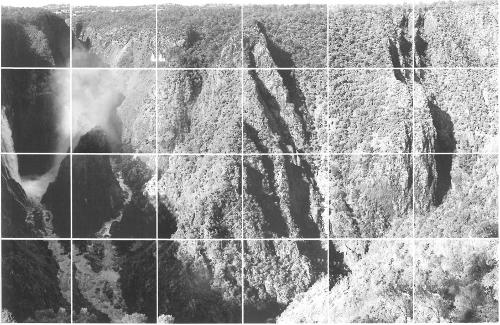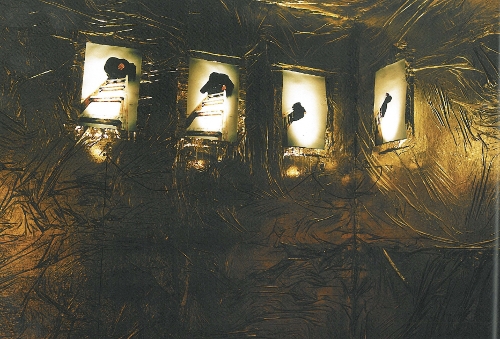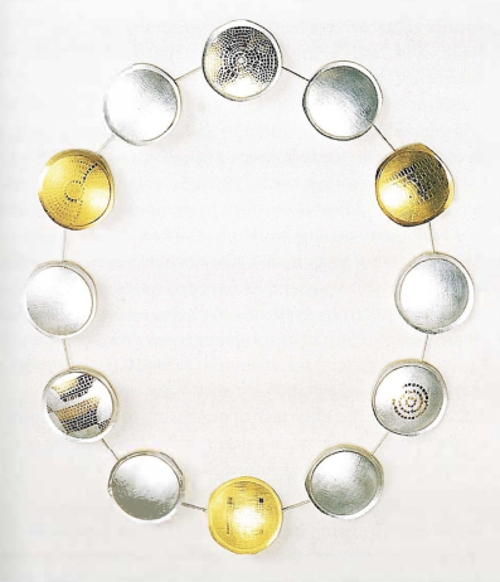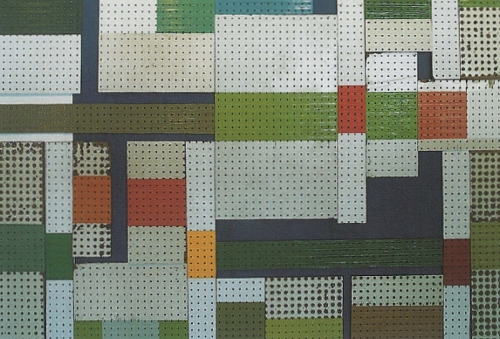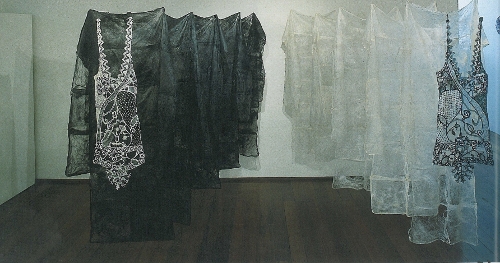Search
You searched in Artist Profile ...

Daniel Crooks
Daniel Crooks is a digital media artist interested in distorting what is familiar to us and offering it back as a study in how we experience time and place. His digital manipulation of everyday materials and landscapes such as trains, trams and the passages of pedestrians across public spaces transform the work into a vibrant palette of colours and textures. Crooks is an artist who creates moving images that engage the viewer beyond and beneath the surface of the screen.

ex de Medici: Symbols of Mortality
ex de Medicis self-named approach to her practice Dogs Breakfastism signals an idiosyncratic working method that has seen her embrace photocopy, sound, performance, photography and drawing across a three-decade career. Kelly Gellatly looks at the multifaceted creative occupations of de Medici as both a visual and tattoo artist and the inherent connection she makes in and between these two practices. This text looks at two of de Medicis most prominent series - Gals n Guns and Spectre - through which she explores pressing issues such as global capitalism, corporatisation, materialism and the ongoing war on nature.

Yvonne Boag: Mapping Place, Memory and Conversations
Yvonne Boag is a traveller, a wanderer and keen surveyor of her surroundings. Her concerns of language and place traverse a myriad of media such as paintings, prints and drawings in a career spanning three decades. As Boag commented in 1989 With every new work I start, it seems I am always at a beginning. Each work is an attempt to hold on to time. To make marks of that time, which will trace a pattern through my life& Through this text Donna Brett looks at Boags journeys to places such as Korea, Paris and the Lockhart River and her use of iconography and dense layering as a means of mapping her interaction with places, journeys and people. Some artistic influences here discussed include the works of Roger Hilton, William Scott, Ben Nicholson, Patrick Heron and Avis Newman. The Lockhart River, Urban Landscape and Conversations series are referred to in considerable detail.

Heather Ellyard: Inventories and Commentaries
Heather Ellyards valued objects are static, symbolic, juxtaposed rather than flowing. Ellyard asserts that she wants to speak the lyrics and sorrows of our time. As she has said, I am interested in the glimpses, held, remembered, aligned inclusively&I am interested in awareness and how to acknowledge it within a visual framework. It may be that Ellyards vision of the periodical table is a bridge: between life made up of many little things and the one big thing toward which we all yearn. She leans more to wisdom art than to the mimetic or the sublime. Ellyards art is incorrigibly plural, and sustainedly committed to the broadest kind of human vision. Textual references include the works of D.W. Winnicott, Jacob Rosenberg, Arthur Koestler, Basquiat, Brett Whiteley and Primo Levi amongst others.

Robert Owen: A Different Kind of Modern
Robert Owens longstanding interest in exploring dimensions of light and space beyond the merely visual reaches back into an important line of constructivist art of the early twentieth century. Experiments with form and material have characterised Owens practice throughout his career, as has his openness to heterogeneous influences. Some of the major influences on Owens practice include metaphysical philosophy, Buddhist spirituality, optics, geometry in physics, minimalist sculpture and the work of Marcel Duchamp. This article refers to the works of Naum Gabo, De Stijl, Russian Constructivism, Bauhaus, Lynden Dadswell, Walter Gropius, Chairman Clift, George Johnston, Leonard Cohen, Jack Hirshman, Jean-François Lyotard, Charles Biederman, David Bohm and Stephen Hyde.

Becalmed: The Art of Going Nowhere in the Work of Nicholas Folland
Becalmed: the art of going nowhere in the work of Nicholas Folland

Sara Hughes: The Big Stick Up
The symbolic and perpetual possibilities of pattern are constantly under interrogation in the work of Sara Hughes as she is compelled to inhabit the capricious edges of what painting might be. Being a child of her times, Hughes was part of the sticker generation who adorned the unsuspecting surfaces of schoolbooks, bedroom walls, wardrobes, mirrors and fridges. She applies similar processes to her work as a means of mimicking the act of making something ones own and thus reinforces the claiming and transforming of spatial environments. This article follows Hughes practice through the visitation of childhood moments while simultaneously offering a platform for new conversations about spatial interplays and the shifting dialogues between surface and form, codes and perception and graphic modes and painterly references. Some of Hughes' primary influences include William Gibsons 2003 novel Pattern Recognition and the works of Yayoi Kusama, Takashi Murakami, Yoshinori Tanaka and Sergio Leone.

Renate Nisi: Sculpture of the Senses
Renate Nisi is obsessed by being packaged in a body, that condition common to humans, other animals, plants and even microbes. Growing up in Germany, where 'art had epic qualities', she flirted with the Sublime and the Romantic but converted to Expressionism 'with the figure as central motif.' A further shift has occurred since then, towards minimalism and three-dimensionality, 'away from the sovereignty of forms onto the relational qualities of environments.'

Chris Mulhearn: Stand of Trees
Chris Mulhearn is an Adelaide-based artist who breathes the world around him. Where some artists make work in the bush, others like Mulhearn bring elements of those places into the heart of the world of constructed reality, the art gallery, and successfully. His work is recycling to die for.

Place Works: India Flint
India Flint's textile practice seeks to articulate the cyclical connection between human existence and the patterns of nature. She researches traditional dye practices with old approaches being re-examined to generate more ecologically sustainable methods of production and uses indigenous plant forms and declared noxious weed. As the cloth absorbs colour from materials extracted from the landscape, so it becomes steeped in the landscape itself.

Place Works: Martin Walch
Over the last five years Martin Walch has been working on the Mt Lyell Project as an artist in residence with Copper Mines of Tasmania. The project is ongoing, and now consists of a number of sound recordings, animations in 2D and 3D, stereoscopic pairs in travelling cases, as well as large re-photographic works based on J.W.Beatties' Mt Lyell photographs from 1893-6.

Place Works: Tim Maslen and Jennifer Mehra
Tim Maslen and Jennifer Mehra are Australians who live and work in the UK and have appropriately developed their body of work based on the experiences of disjunction one feels when removed from their familiar physical environment. Their artificial landscapes act as metaphors for the difficulty humans have in overcoming epistemological delusion and acknowledging the fact that life in the world is a unitary experience. We can see Maslen and Mehra's work as a kind of ritual to help us reconcile ourselves with our origins.

Place Works: Bette Mifsud
The body of work shown as The Living Room (RMIT Gallery 2001) continues Bette Misfud's studies of the emotive and emblematic power of landscape imagery. The Living Room represents, in part, the cultural segregation and physical isolation Misfud experiences in rural life as a second-generation migrant. The land is continually transformed by the marking and scarring of our habitation. Thus both land and identity are in a continual state of flux.

Place Works: Bronwyn Wright
Bronwyn Wright's work has closer links to the stealth associated with graffiti artists and the flamboyant play of the theatre than to large scale earthworks. It is based on intimacy with the site, daily visits, observations of seasonal variations and an anonymous interaction of dialogue with a young sub-culture. The ruined cars which adorn the site of 'The Swamp' where Wright works are symbolic mediators between earth and technological man. The car bodies wear away, crumple and disintegrate as the land itself is torn and worn and as our own bodies tire and retire.

Traces of a Shared Memory
Julie Blyfield's recent work explores her family history and her own sense of place and identity through the objects that have been handed down to her from her grandparents. Her grandmothers embroidery was a specific reference point for this work, as she metaphorically 'unpicked' her designs and reinvented them through her own medium.

River Systems
The work in River Systems responds to the region Ian Tully lives in, the south western Riverina of New South Wales and the surrounding country. The intention of his work is to question the whole notion of sustainability. Tully is continually torn between the design and aesthetics of industry, and the fragility, beauty and sensitivity of our diminishing natural systems.

Michele Barker
Michele Barker is a Sydney-based artist working in the area of new media. Conceptually, her work has concerned itself with notions of bodily identity, difference and in more recent times, the relationship between science, medicine and corporeality.

Ray Cook
Ray Cook is a Brisbane-based photographic artist who has exhibited for 13 years with 20 solo shows to his credit. Cooks work has been primarily concerned with mortality, loss of control and the way gender and sexuality have been perceived in the media. His images are highly theatrical, staged scenarios, a hybrid of performance and still photography.

Monika Tichacek
Monika Tichacek is an installation artist based in Sydney. Her performance installations exist as a space within fiction, dreamlike. In both of Tichacek's works I Wanna Be Loved By Youand Romancethe view of the human is mediated by a surveillance camera, echoing the receding of the surgically enhanced body from human towards post-human.

Tiffany Parbs
Tiffany Parbs reinterprets 18th century medical tools to create works of small objects which carry with them an implication of an intimate relationship with the body. Parbs is based in South Australia at the JamFactory Contemporary Craft & Design; her project has been assisted by Arts SA and the Australia Council.

Lynne Roberts-Goodwin
Lynne Roberts-Goodwins work with birds is the latest chapter in her 20-year practice using digital photography. Her current work involves the research and image capture/production of animal habitat and migration using infrared and supplementary daylight fibre-optic lighting with digital image and video capture technologies.

Steven Holland
Steven Hollands pests/pets, DEED and being are a part of an ongoing series of ephemeral investigations into the representation of animal life. Underlining this is an exploration into the act of looking and the dominance of human vision. Holland was born in Dwellingup, WA, and studied at Curtin University, Canberra School of Art and at the Royal College of Art.

Jane Trengove
Jane Trengoves new paintings of monkey faces are the latest work in her long investigation into the human/animal interface. Trengoves intention with her series Looking Back is to grasp the moment of recognition from the human point of view and reverse the subject and object positions of the gaze. Trengove was born in Melbourne and studied at East Sydney Tech and at the Victorian College of the Arts.

John Kelly
John Kelly paints cows and horses, in particular, the legendary Phar Lap and Dobell's camouflaged bovines. Through using these narratives and adding new elements Kelly has created a multi-layered structure of ideas. This evolution works on a slow time scale that is at odds with today's fast consumer culture where products need to be refreshed and changed on a continual basis.

Melinda Rackham's Online Installations
Time is the key. They say that the only law of physics that absolutely requires time is the second law of thermodynamics, the law that says systems tend towards entropy. That tendency is time's arrow, the ineluctable winding down of the universe. Except, of course, for life.

Jon McCormack's Evolving Ethics
Most readers would probably have noticed that talk about A-life technology (or any technology for that matter) has a definite shelf life. Liminal Product [LP] quizzed internationally acclaimed computer artist Jon McCormack, whose paper [Re]Designing Nature given at dLux media arts FutureScreen symposium on Artificial Life in October 2000, and recent piece, Eden exhibited at Cyber Cultures, Casula Powerhouse, in the same year, articulate many of the concerns about A-Life that Australian artists grapple with.
Lin Onus - Cultural Mechanic
Contemplating the work of Lin Onus the artist, the arts administrator and the panel beating mechanic.
Contemporary Australian Aboriginal Art
Mural at Port Lincoln: Kerry Giles and Melanie Howard
Kerry Giles and Melanie Howard talking to Felicity Wright about the mural in Port Lincoln South Australia.
Contemporary Australian Aboriginal Art
Peter Dabah
Dabah was the Aboriginal Artist in residence at the Flinders University 1989 - 1990.
Contemporary Australian Aboriginal Art
Robert Campbell Junior
The artist talks about his art practice.
Contemporary Australian Aboriginal Art
Two Profiles from Cairns: Tatipai Barsa and Zane Saunders
Looks at the art practice of two artists from the Cairns College of TAFE and the Associate Diploma of Art.
Contemporary Australian Aboriginal Art
Shane Pickett
Looks at the works of West Australian artist Shane Pickett.
Contemporary Australian Aboriginal Art
Gordon Bennett: Expressions of Constructed Identity
Gordon Bennett interviewed on the development of his work.
Contemporary Australian Aboriginal Art
Gayle Maddigan
Looks at the art practice of Victorian artist Gayle Maddigan.
Contemporary Australian Aboriginal Art
The Route You Take...
Photographs of Fiona Hall's work The route you take... installation shot and details, aluminium soft drink cans
Contemporary Art Centre
October 1990
Australian Centre for Photography
November - December 1990
10th Birthday Issue
Julia Ciccarone
The artist writes about her art practice, in particular her preoccupation with the Australian landscape and how people perceive it. Two images are included: 'Secret Self' and 'Blanket' both from 1990.
Arts in a Multicultural Australia
Elizabeth Gertsakis
Illustration of her current art practice. Includes images of her work 'The Boys in the Band' from 1989.
Arts in a Multicultural Australia
Zsuzsa Kollo
Looks at the ceramic works of Zsuzsa Kollo which refer to Pre-historic, Eastern, and Christian works. includes b/w photo.
Arts in a Multicultural Australia
Janusz Kozak
Looks at the art practice of Januzs Kozak, a painter who was born in Poland and who now works and lives in Wollongong.
Arts in a Multicultural Australia

